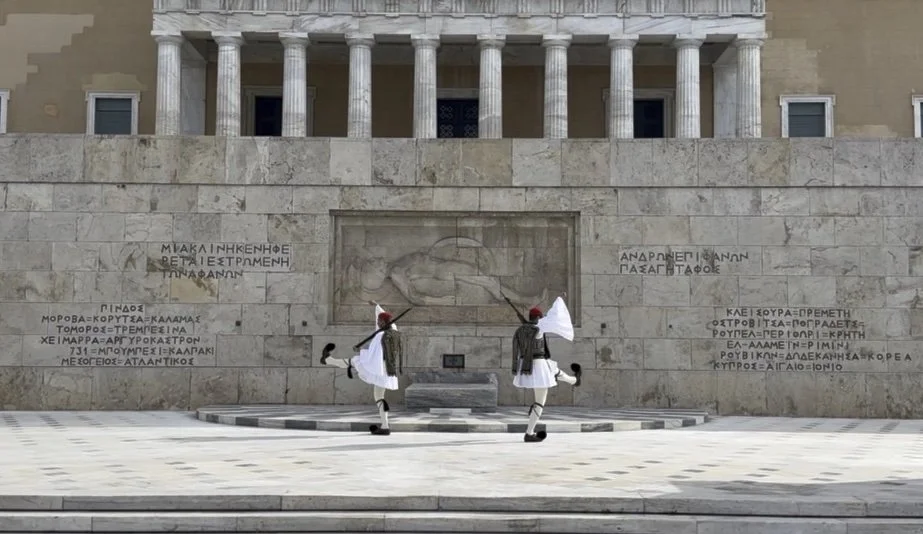A Glimpse into Tradition: The Grand Change at the Greek Tomb of the Unknown Soldier
The streets of Athens, Greece are quiet and abandoned on this—and every—Sunday morning, in part because many people are at church. Kevin claims it’s equally because people party well into the wee hours on Saturday nights. We know this because the thrumming sounds of local bars and people shouting reverberated through our windows! We don’t mind because we thrive on this type of street energy. We venture out to fortify ourselves at Overoll Croissanterie, one of the few bakeries open. Double cappuccino for each of us, pain au raisin for Kevin, and a delightfully crunchy spinach croissant satisfied me.
Evzone guarding Presidential Mansion, Athens, Greece
Earlier in the week on our e-bike tour, we stopped to see the Evzones (military guards) ceremonially guarding the Presidential Mansion while standing stock still, similar to the Buckingham Castle guards in London. Greek men are required to serve in the military after high school, and if you’re over 6’1” tall, there’s a good chance that your service will involve working as an Evzone.
I’d read that there is a splashier changing of the guard that happens on Sundays at 11am in Syntagma Square at the Greek Tomb of the Unknown Soldier called the “Grand Change.” We arrive 30 minutes early to try to get a good view of the process. I’m only 4’11”, so unfortunately, I’m fairly out of luck because people have been here for much longer. If everyone nearby stays perfectly still, including the young girl with the high ponytail catercorner to me, I will have a sliver of a sightline to the action. I’m protective of the small boy who unsuccessfully tries to go underneath the tall woman in front of me. I encourage him to continue to try to wiggle his way into a better spot and wish the woman were a bit more self-aware of the child scrambling to catch a glimpse so she would make space for him.
Changing of the Guard, Greek Tomb of the Unknown Soldier
We hear the marching band on the street before we see them enter the square and lead a platoon-sized cadre of guards to the tomb. Kevin pivots from the spot I’m in and magically has a great view and is able to record the pomp and circumstance. The “green guys” as they’re described—sergeants if you want to be more precise—are going down the row and ensuring that the guards’ garments are perfectly aligned. I spy that one knee stripe is slightly askew on one of the soldiers, and a moment later, a sergeant has adjusted them both to be in perfect parallel. The rotation is ready to begin.
Their movements are in perfect synchrony, slow, precise, and exacting. It’s an intricate dance and their exaggerated leg movements are reminiscent of horses. They scrape their feet and clop along with special footwear. Their extreme movements are meant to help with circulation since their post requires them to remain perfectly still and expressionless for an hour. The white skirt of the uniform has 400 folds to represent the 400 years of Ottoman occupation over the Greeks.
The elegant ceremony that has been recreated every week for the last 154 years eventually concludes as the new guards are installed in their posts. The bulk of the crowd eventually disperses, but we linger. Our patience is rewarded with a close-up, obstruction-free view of the next rotation, which happens every hour on the hour.
Despite the chilly day and minor crowds, we feel extremely fortunate to witness such a fulfilling version of this tradition. We may not be able to soak in the sun on the beaches here in January, but the reduced number of people we had to navigate for this view in the off season makes January in Greece a great time to visit.



